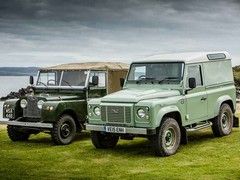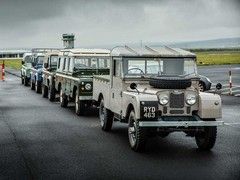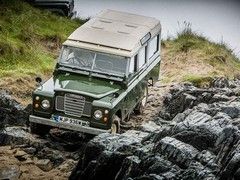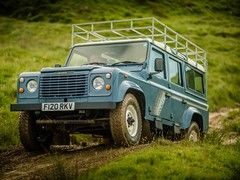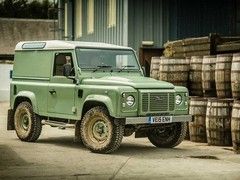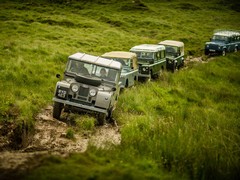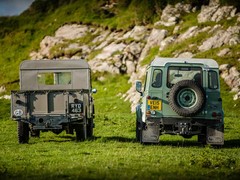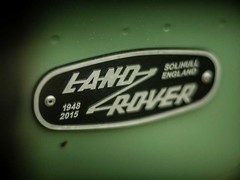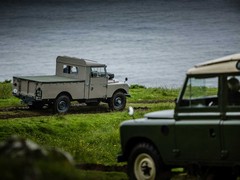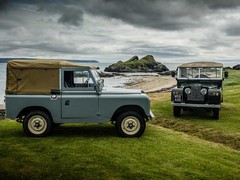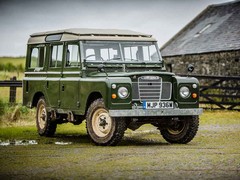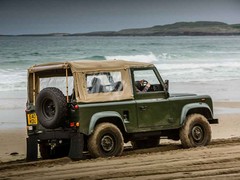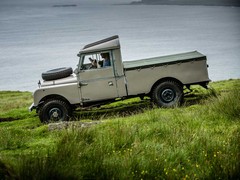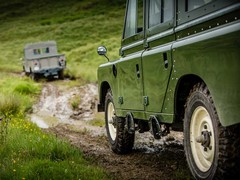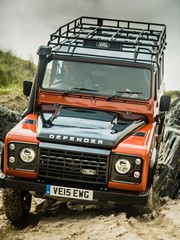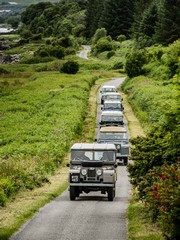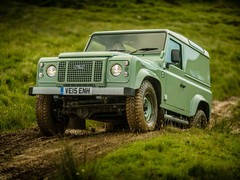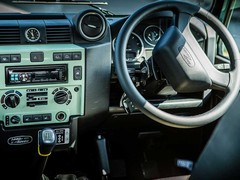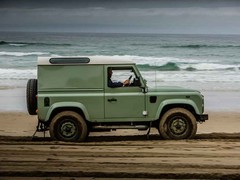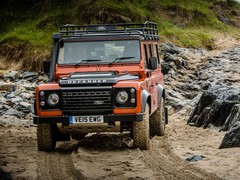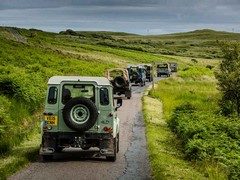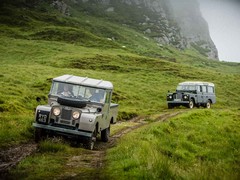Every Land Rover in a day
From Series I to Heritage Edition run-out - PH drives every Land Rover in a tearful goodbye

Don't laugh, but the Defender also has the some of the same ultra-specialised appeal of a Caterham or an Ariel Atom; you know it's compromised at 90 per cent of the things you expect a car to do, but it's utterly brilliant at the other 10 per cent. In an era when the Land Rover brand often seems to be more about 32-way electrically adjustable comfort seats and c'leb endorsements than crossing deserts while eating ration packs, the Defender remains very much The Real Deal.
Which is probably why its long-delayed passing has provoked such a strong emotional response. Apparently so many people have placed orders on the back of the retirement that the plan to stop production in December has had to be pushed back into next year.
And as part of the official goodbye Land Rover held an event that offered the chance to drive a full set of classic Landies, from a Series I through to the run-out limited edition Defenders, 67 years of very gradual evolution in one day. As a self-confessed Land Rover geek it felt like being thrown the keys to a sweet shop.
Landy Island
The event took place on Islay, the Hebridean angle chosen not just because of scenery and the many whisky distilleries, but also because this is where the Wilks brothers - the senior Rover executives who created the first Landie - had a Scottish estate. It was here, the legend says, that over a generous dram they came up with the name Land Rover. Good enough for us.
On arriving at the tiny airport we find that pretty much the entire car park has been filled with a line of Land Rovers, parked in chronological order and demonstrating the clear similarities between the first and last. Doing things chronologically means starting with the Series I, in this case a gorgeous 109-inch Pick-Up that a private owner has very generously loaned for the event.
It's a 1954 car, meaning six years into production, giving it the later and fractionally more powerful 51hp 2.0-litre engine and part-time four-wheel drive; the first ones had a 1.6 and a crude permanent system. The original plan had been to build the Land Rover around a central seating position, on the grounds that most owners would be farmers familiar with tractors, but perhaps sadly that chance to create an agrarian McLaren F1 45 years ahead of time didn't pan out. The surprise is, that by the cramped standards of 1950s British cars, the cabin feels impressively spacious - although you won't be surprised by the complete lack of luxury; apart from the fabric on the seats there's no actual trim at all.
I've driven a Series I before, but it was nothing like as good as this one, which feels practically factory fresh. The controls are nicely weighted, and beyond its initial slack the steering even manages some nice feedback. Performance is minimal: 45mph seems a comfortable cruising speed and you need to double-declutch on downshifts as there's no synchromesh on first or second gears.
Onwards and not quite upwards
The Series II is a disappointment, as it doesn't feel quite as nice as the Series I. The car on Islay is a 1965 88-inch Soft Top which belonged to Spencer Wilks himself and used to live on the island. It's got more power, 66hp from the 2.25-litre petrol engine that Land Rover would use for more than two decades, and its gearing is shorter too. So it's quicker, but also far louder, and with a mushy brake pedal and a jarring ride on its short wheelbase.
Swapping to the Series III triggers an instant wave of nostalgia; like most people who grew up in the 70s and 80s I spent time riding in the back of various examples, experiencing the puke-making combination of the bouncy ride and aroma of vinyl trim. The interior is a huge leap forward from the Series I and II, but now feels as craptabulous as pretty much everything else BL did back then. It's nice to drive, though - still slow, but with more accurate steering and synchromesh on all its gears. I get to drive it off-road as well, where it shrugs off the challenge of a rutted and rocky track that leads to a beach. It also gets bug screens for the pop-open air vents beneath the windscreen, a move that probably had some of the brand's early fans suggesting the Land Rover was getting a bit soft and effete.
Acceptable in the 80s
Next, the Defenders. Well, not quite, the Defender name was only introduced in 1990 - as part of a plan to relaunch Land Rover into the States. From the first seven years of its life the "modern" coil-sprung Land Rover was just known by its wheelbase. There are two 1988 versions to drive, a 90 Turbo Diesel and a 110 V8 Station Wagon.
From the outside they look almost identical to the modern Defender. Many parts are common; the mirror mouldings are the same. But inside their low-rent interiors feel closer to the Series III. The Turbo Diesel is very slow and loud with little evidence the boost is doing very much; it struggles to get to 60mph, let alone past it. The V8 is lovely with a wuffling soundtrack from the low-stressed 3.5-litre Rover engine (producing just 130hp) that masks the fact it isn't very fast either. 15mpg economy would probably get boring quickly as well.
Defender of the Realm
You wouldn't have thought it was possible for a modern Defender to feel like a dynamic paragon, but after experiencing the earlier Landies the retro-themed Heritage Edition I drive first feels like a sports car. The steering is far tighter, the chassis responds to basic instructions without wibbling and the Ford-sourced 2.2-litre turbodiesel produces meaningful shove. There's even a rev-counter.
In years to come it will probably be possible to date any Defender by a scientific study of its switchgear; the Metro wiper stalk and headlamp switch survived from beginning to end, but other bits have joined practically year-by-year - Montego electric window switches, Rover 200 buttons. This must be one of the last vehicles on sale with a DIN-size stereo, not to mention the flat glass of the windscreen. It's just a shame that the opening air vents were axed a few years ago: now there's just flat metal beneath the windscreen. The seating position is as tight as ever, you soon learn it's best to drive with the window open to give yourself some elbow room.
As well as the Heritage Edition there's also an Autobiography and a very orange Adventure Edition. All drive pretty much identically, although the Autobiography gets a boosted 148hp engine instead of the standard 120hp. That gives a scintillating 12.7-second 0-60mph time, but I have to report I couldn't really feel much difference on the road. The Autobiography also gets two-tone paintwork and a blinged up interior, plus a solidly ridiculous £61,845 pricetag. For that you could have two Heritage Edition station wagons in the unlikely event you find a dealer who could still sell you one. The Adventure Edition has the most visual presence - with some serious underbody protection and an expedition grade roof rack; the one on the island was a 110 Station Wagon that rode far better than the 90s. Those cut alloys look too nice for proper off-road use, though.
Tempus Fugit
But I leave Islay with my belief that all classic Land Rovers are great reinforced, this really is one of those rare cars that is enhanced by some of its obvious flaws. Thanks to Land Rover, Land Rover Heritage and the British Motor Industry Heritage Trust for making it happen.
Final thought: the all-new lifestyley Defender is going to have a serious job on its hands to engender even a small part of the affection this one commands.
Gassing Station | General Gassing | Top of Page | What's New | My Stuff

